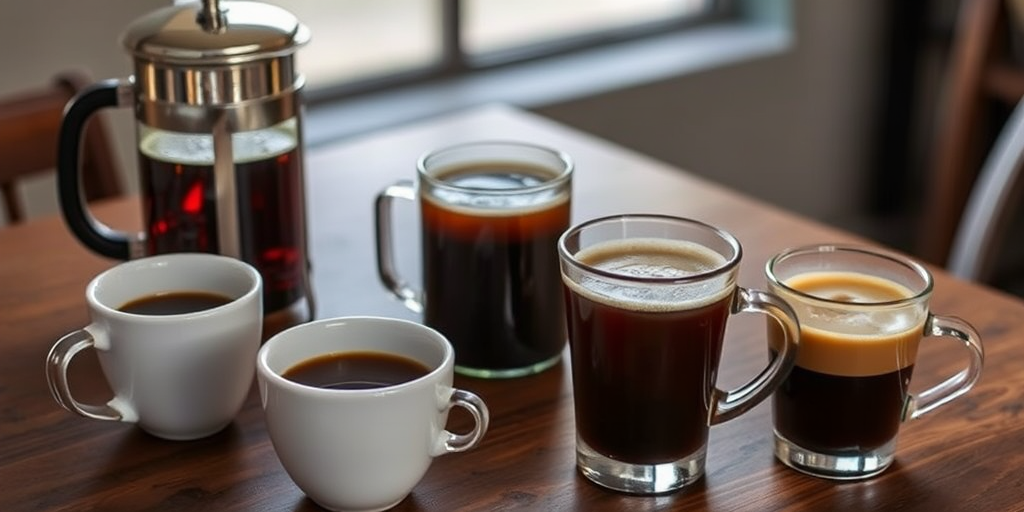Are we truly experiencing every nuance in our cup, or are we missing the science behind our daily ritual? In our exploration today, we detail how distinct brewing techniques—infusion in cold brew, immersion in French press, and pressure extraction in espresso—unlock unparalleled flavor profiles and caffeine effects. We examine these methods through precise, methodical lenses, arguing that understanding their technical differences is key to mastering your perfect brew. Join us in uncovering which process best amplifies the vibrant essence of your coffee experience.
Understanding the Brewing Science: Cold Brew, French Press, or Espresso?

Cold brew operates under the principle of infusion, where cool water draws out flavors from coarsely ground beans over an extended period. The low water temperature yields a sweeter extraction, minimizing the solubilization of bitter compounds. We observe that the larger particle size prevents over-extraction, maintaining a smooth aroma profile while allowing subtle flavor nuances to emerge.
The French press employs immersion brewing, steeping medium-coarse grounds in water near optimal temperatures. Using the Darcy-Forchheimer Law, we understand that a consistent grind size enhances extraction uniformity, ensuring that both oils and aromatic components are evenly released. The interplay between grind size and contact time sharpens the beverage’s body and clarity, delivering a balanced profile that highlights both fruit-like acidity and roasted depth.
Espresso relies on pressure extraction, where water heated between 90-96°C is forced through finely ground beans within seconds. This rapid process extracts concentrated flavors and creates a creamy texture, while the high temperature can elevate bitterness if the extraction time is not closely managed. The fine grind increases surface area contact, resulting in a dense concentration of flavor and caffeine.
- Benefit of optimal grind size: Enhances extraction consistency.
- Benefit of water composition: Improves the balance of dissolved compounds.
- Benefit of extraction time: Controls flavor intensity and prevents bitterness.
- Benefit of temperature control: Maintains precise aroma development and minimizes undesirable compounds.
Equipment, Process Time, and Cost Analysis: Cold Brew, French Press, or Espresso?
We employ distinct equipment for each method. Cold brew can be made with simple, everyday containers, making it accessible and cost-effective. French press brewing requires a dedicated vessel engineered for full immersion, ensuring an even extraction. Espresso demands a high-pressure machine with precise grind size control. These specialized devices highlight the variance in initial equipment investments across the brewing spectrum.
Brewing time is equally decisive. Cold brew relies on an extended steeping period—often around 12 hours—to extract a mellow, smooth flavor profile. In contrast, the French press method completes the extraction in approximately 4 minutes, striking a balance between efficiency and flavor development. Espresso, however, executes a full extraction within 25-30 seconds, producing a concentrated, intensive shot that caters to those craving prompt, robust stimulation.
Cost considerations and home setup ideas naturally follow equipment and time commitments. Cold brew’s minimal equipment needs and long process time make it ideal for budget-friendly setups, albeit with slower turnaround. The French press occupies a middle ground in both cost and process efficiency, appealing to enthusiasts seeking richer flavor without significant expense. Espresso devices, while offering unmatched flavor intensity, often come at a premium and demand precise handling.
- Cold brew: Simple, low-cost equipment with extended steep time.
- French press: Moderate investment with a balanced, brief brewing period.
- Espresso: High-cost, high-pressure system for rapid extraction.
- Process efficiency and equipment precision directly influence home brewing experiences.
Final Words
In the action, we reviewed the distinct brewing processes, flavor profiles, and equipment considerations.
We analyzed factors such as extraction methods, infusion versus pressure techniques, and cost implications.
Our discussion offered a technical yet approachable comparison to guide personal coffee decisions.
By outlining the nuances of aroma, texture, and brewing efficiency, we provided the essential insight needed for an informed choice.
We end with optimism, confident that our evaluation of Cold Brew, French Press, or Espresso? will enhance your daily coffee ritual.
FAQ
What is the main difference between cold brew and espresso?
A: Cold brew uses room temperature water over 12-24 hours for a smooth, less acidic taste, while espresso uses pressurized hot water for 25-30 seconds to create an intense, concentrated flavor.
How does French press coffee compare to cold brew?
A: French press creates a full-bodied, rich coffee in 4-5 minutes using hot water, while cold brew offers a smoother, less acidic profile through extended steeping at room temperature.
Which brewing method has the highest caffeine content?
A: Espresso contains the highest concentration of caffeine per ounce, followed by French press, then cold brew. However, serving sizes typically make cold brew’s total caffeine content higher.
What grind size should I use for each brewing method?
A: Cold brew requires coarse grounds, French press needs medium-coarse grounds, and espresso demands a fine grind for optimal extraction and flavor development.
Which brewing method is most cost-effective for home use?
A: French press is the most economical, requiring minimal equipment. Cold brew needs basic containers, while espresso machines represent the largest investment.
How do flavor profiles differ between these brewing methods?
A: Cold brew produces smooth, sweet notes with low acidity. French press delivers rich, bold flavors with natural oils. Espresso creates intense, concentrated flavors with crema.
What’s the ideal brewing time for each method?
A: Cold brew requires 12-24 hours of steeping. French press needs 4-5 minutes of brewing time. Espresso extracts in 25-30 seconds under pressure.

